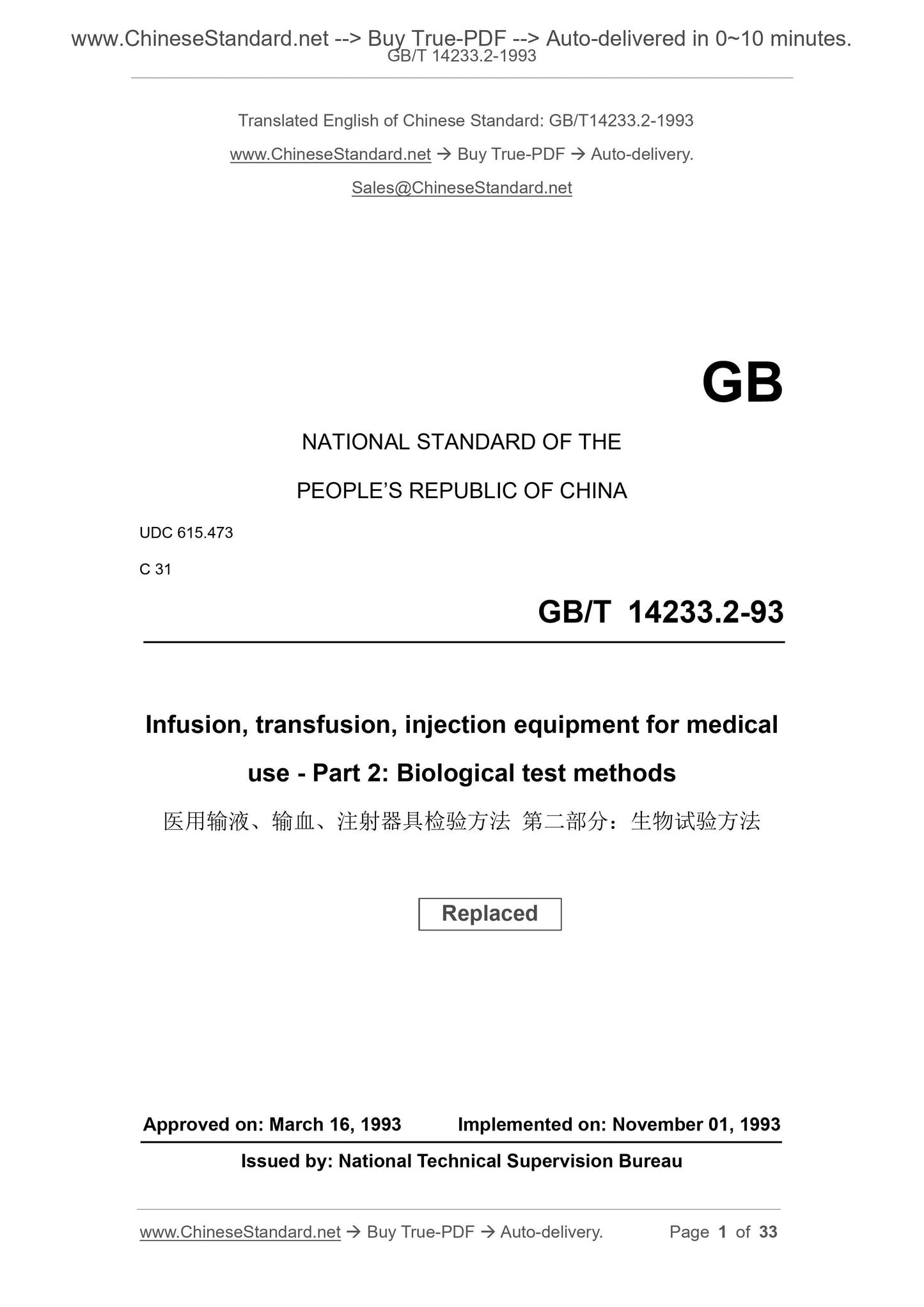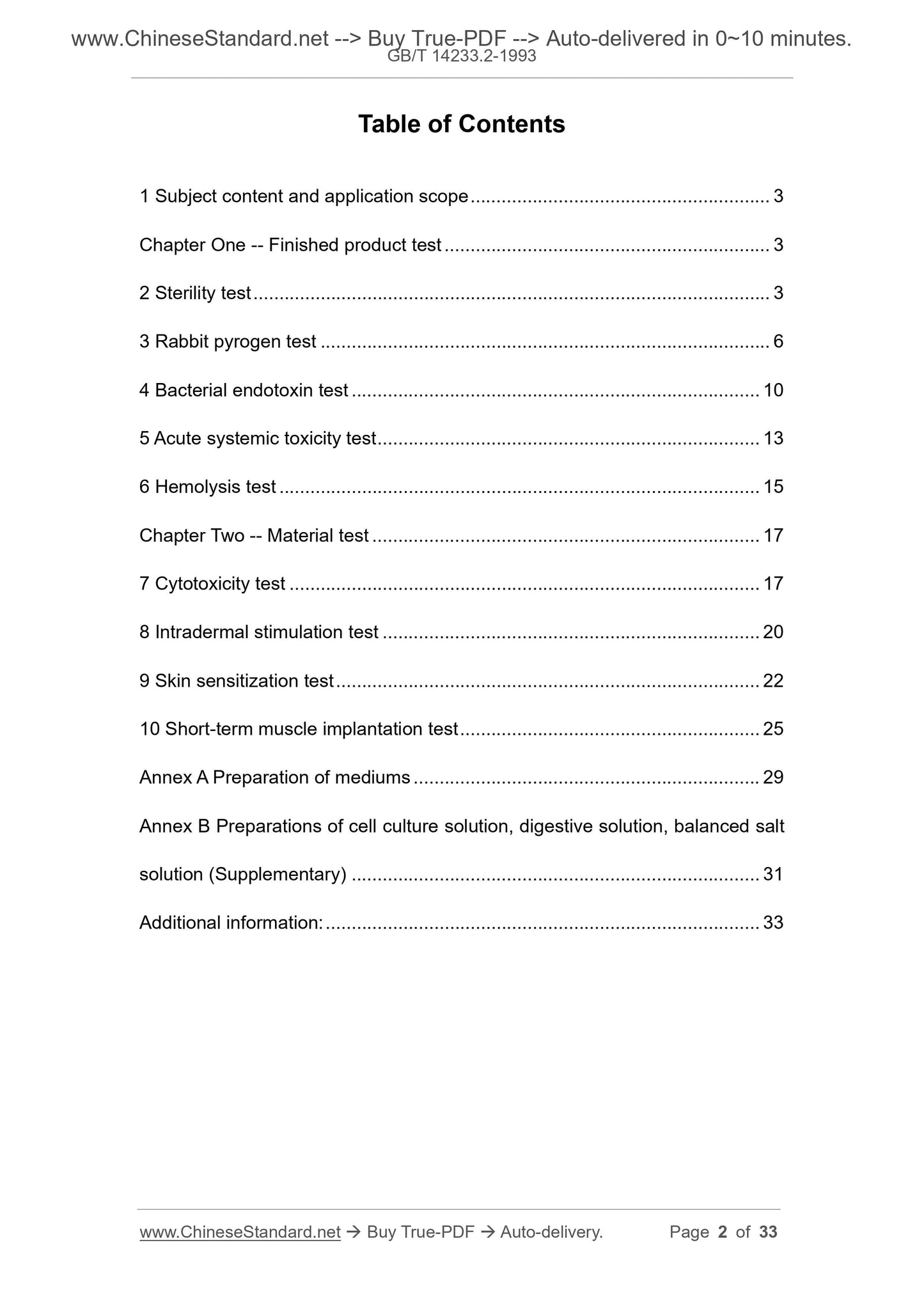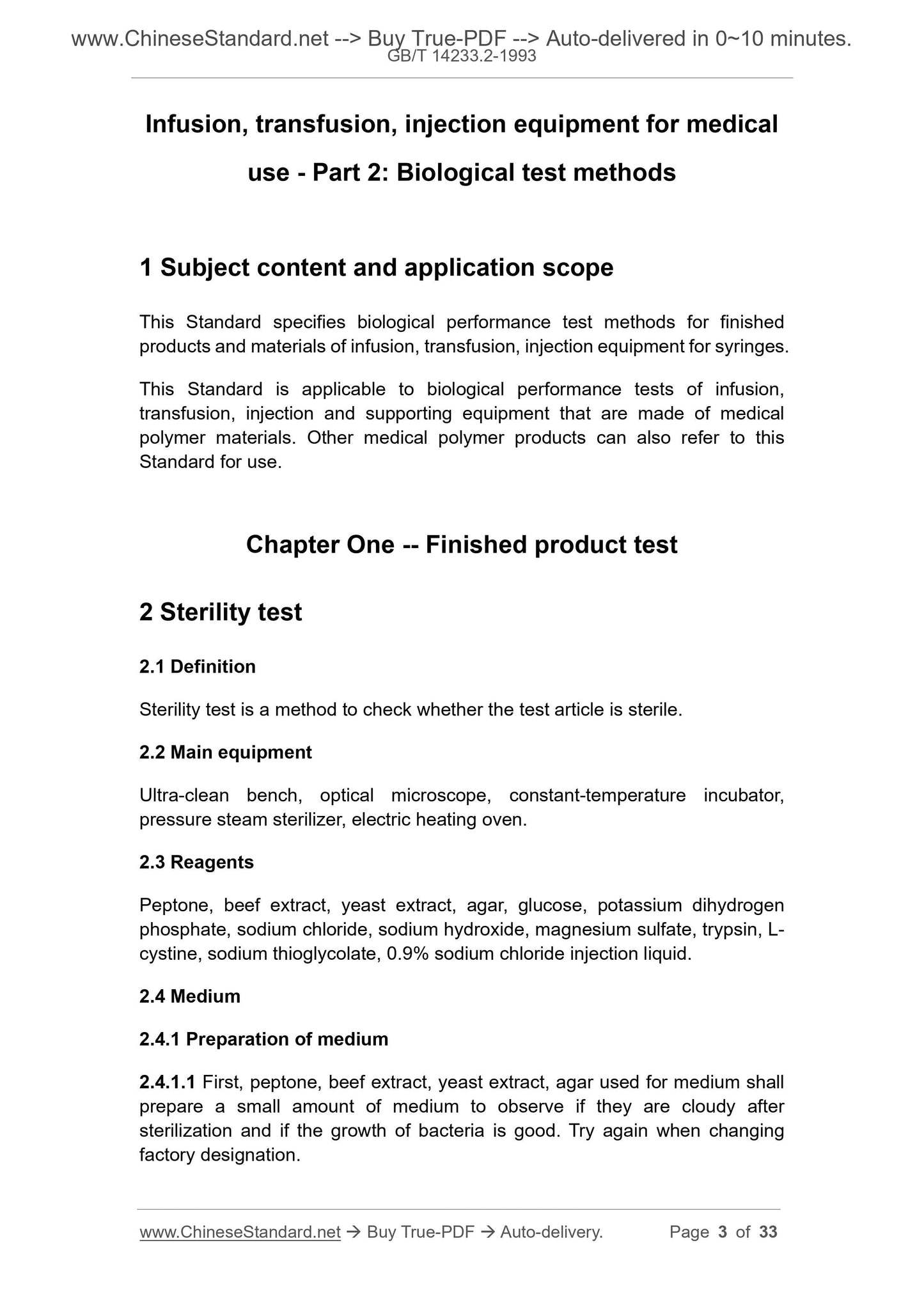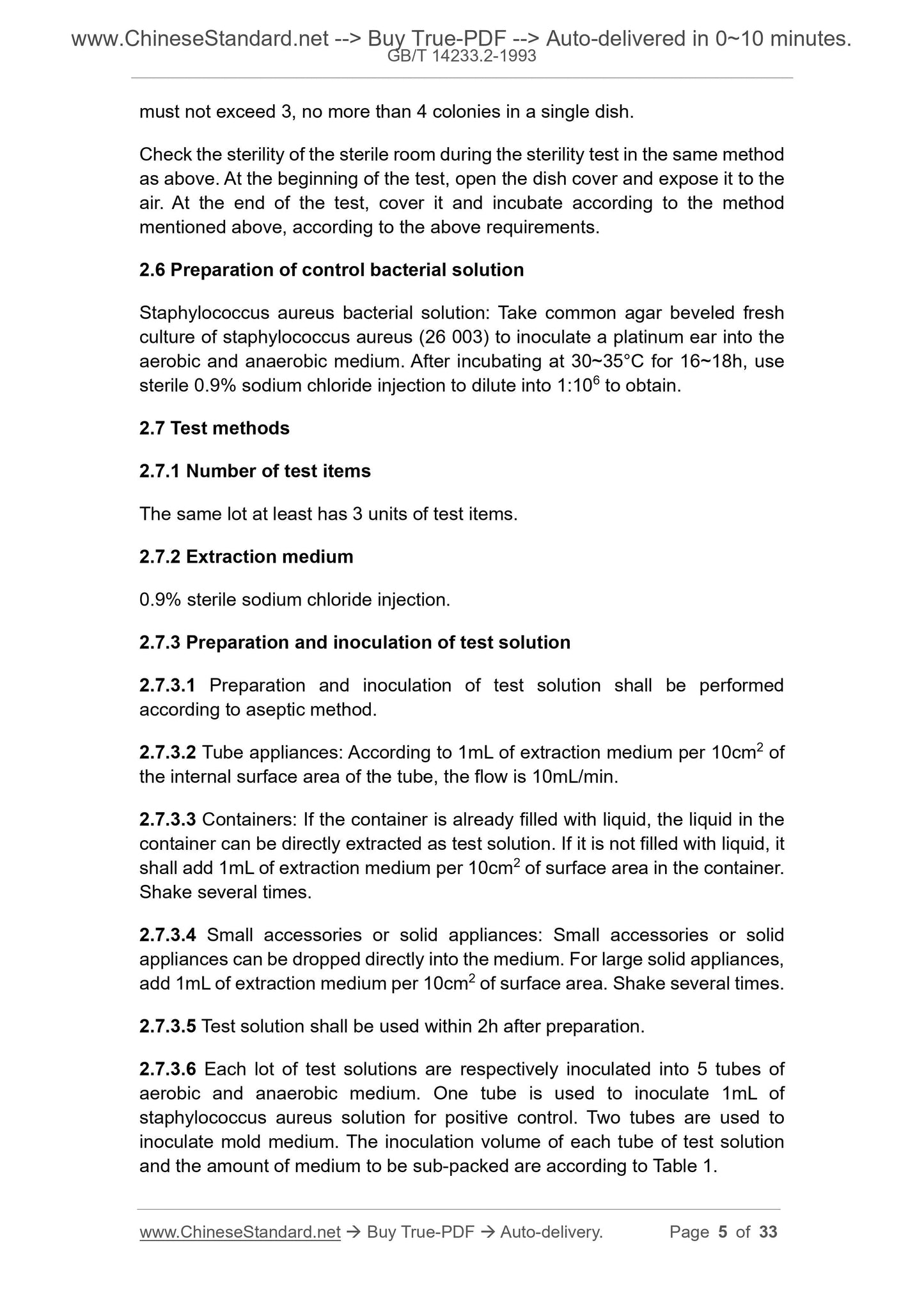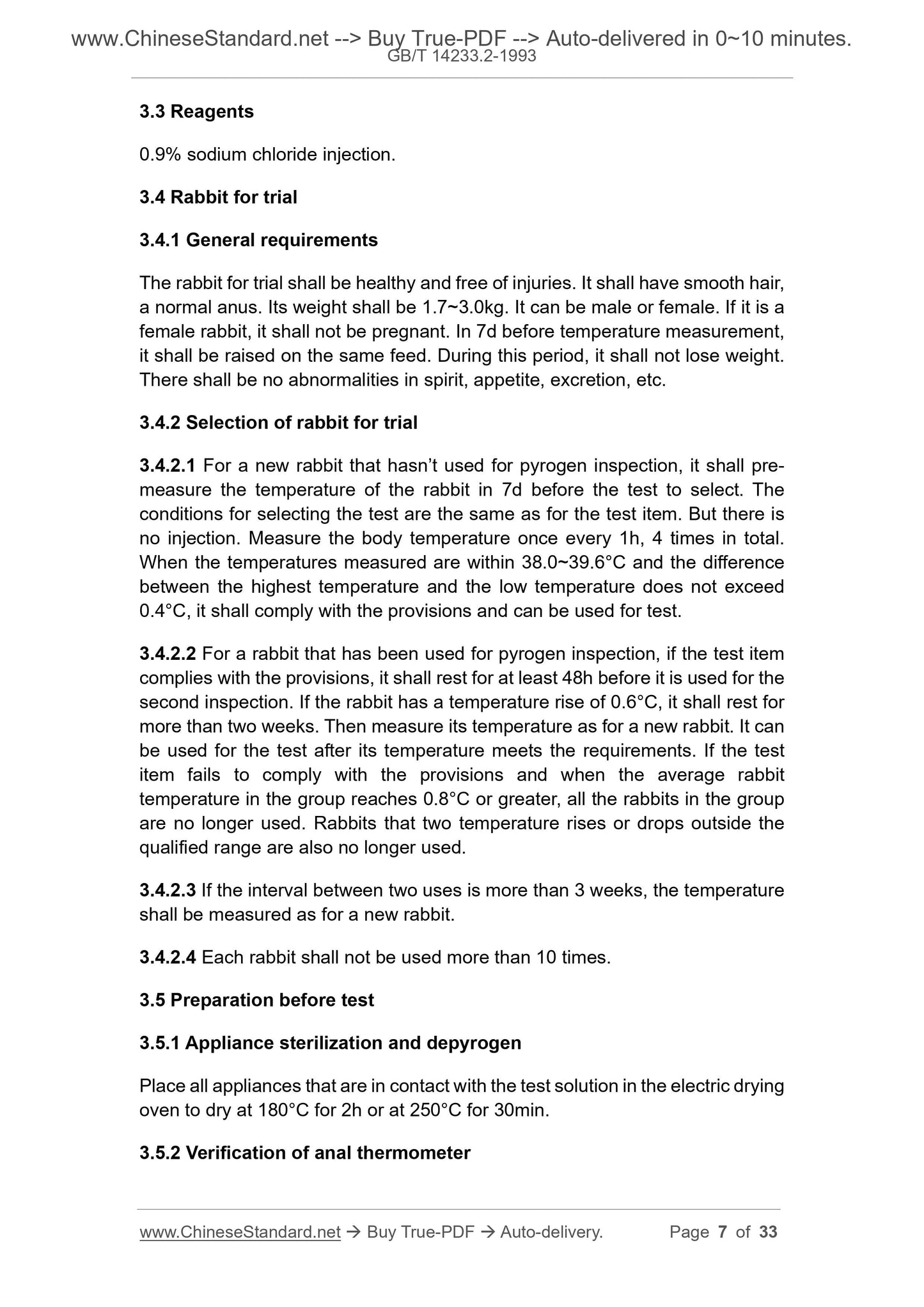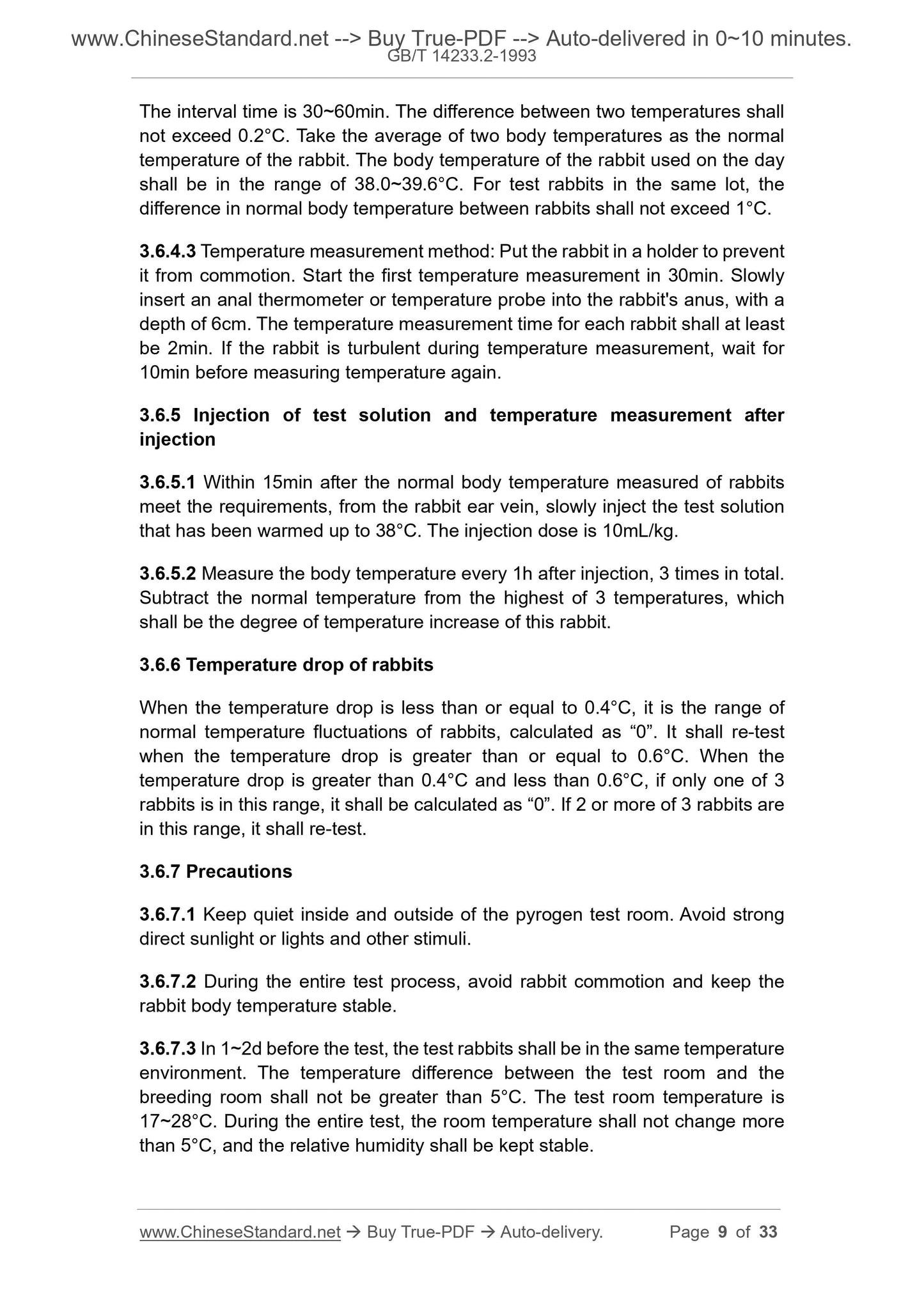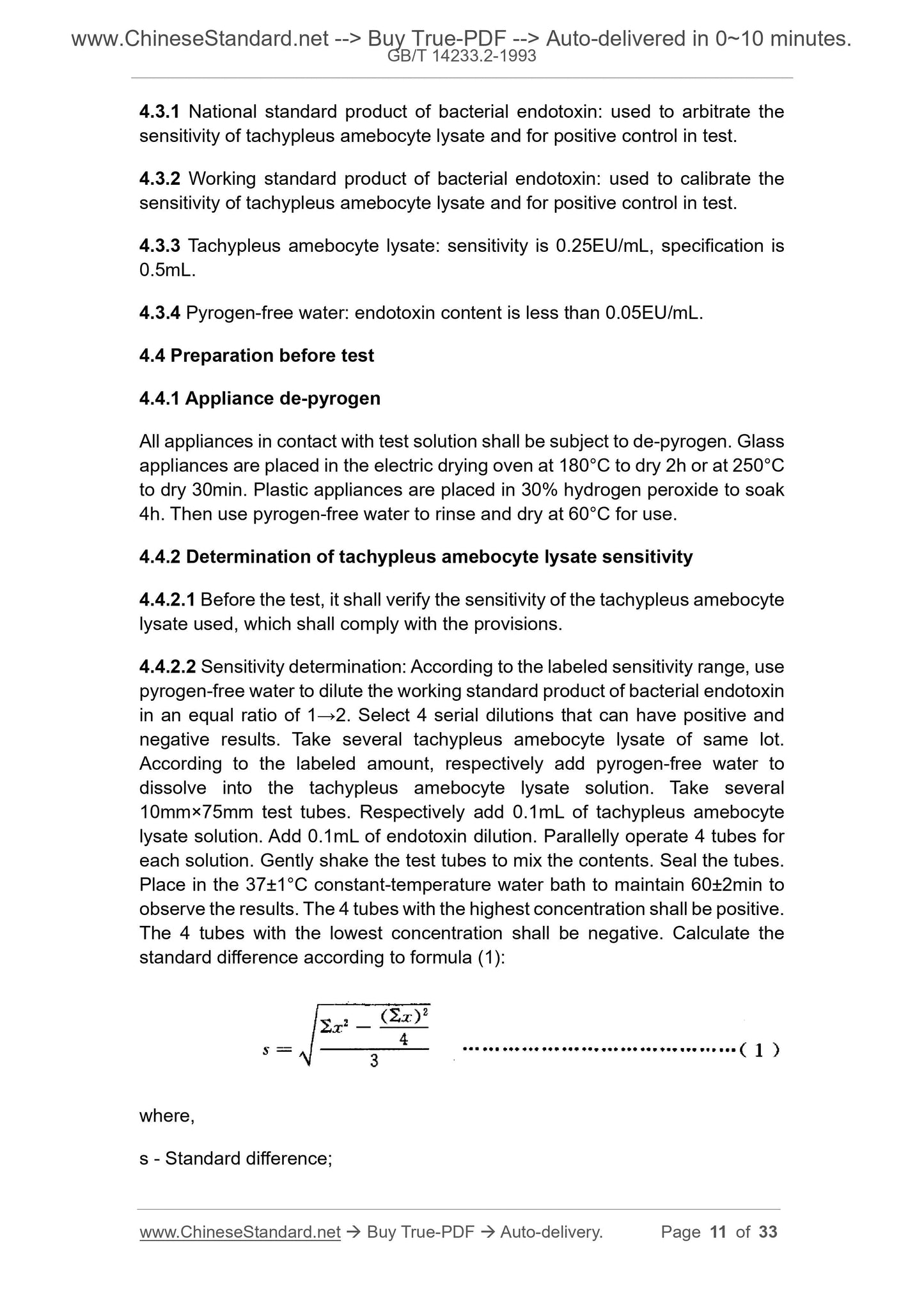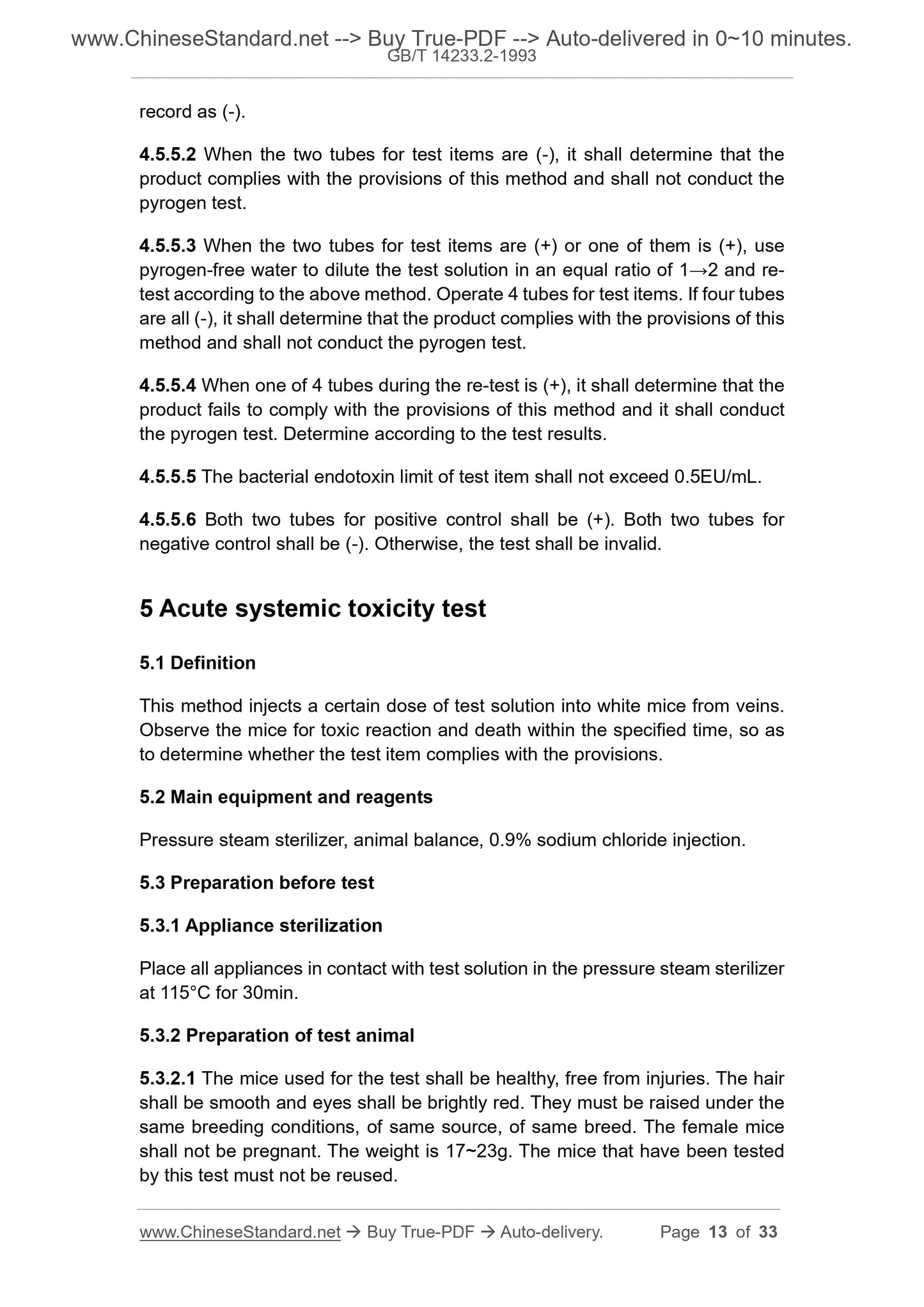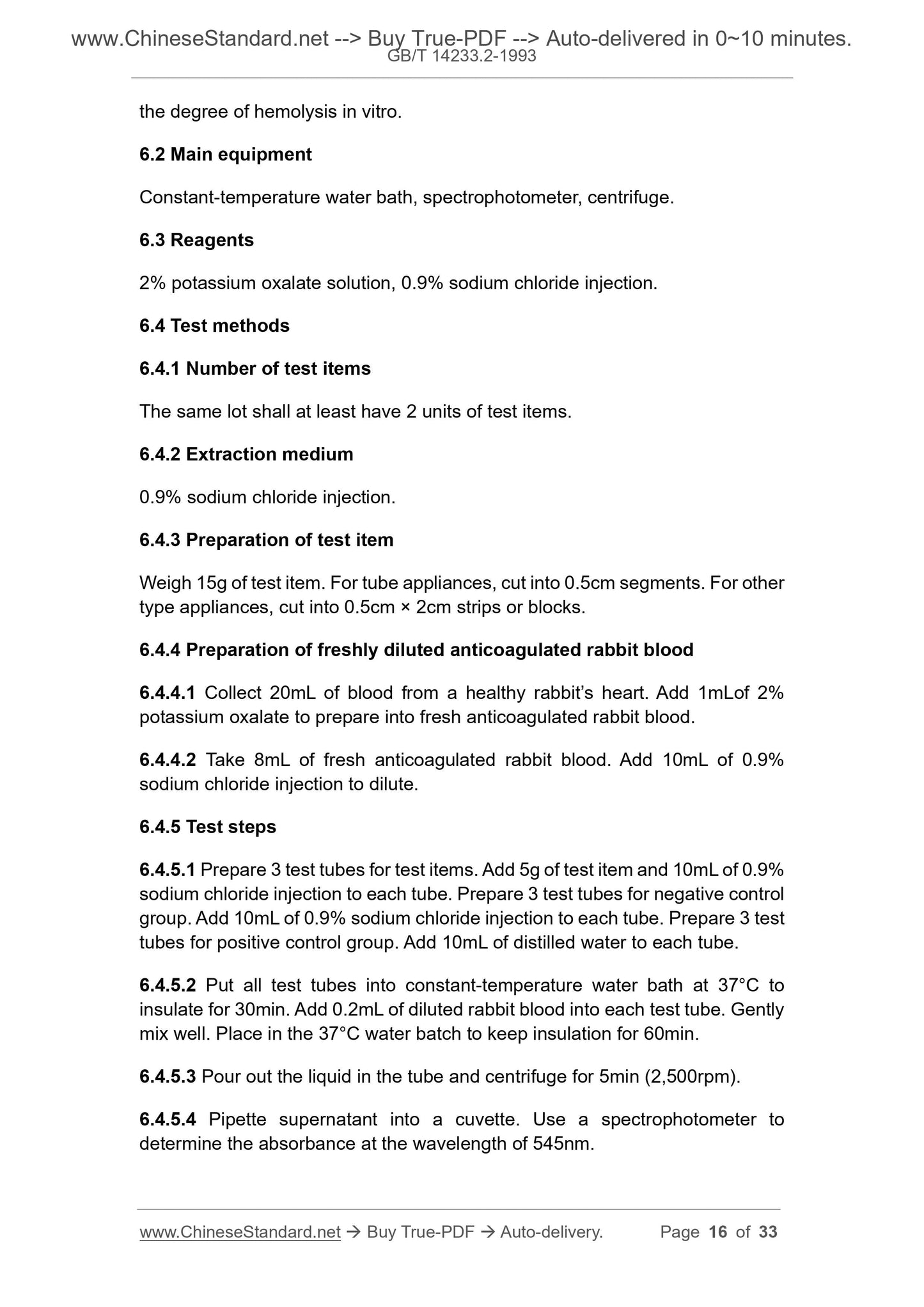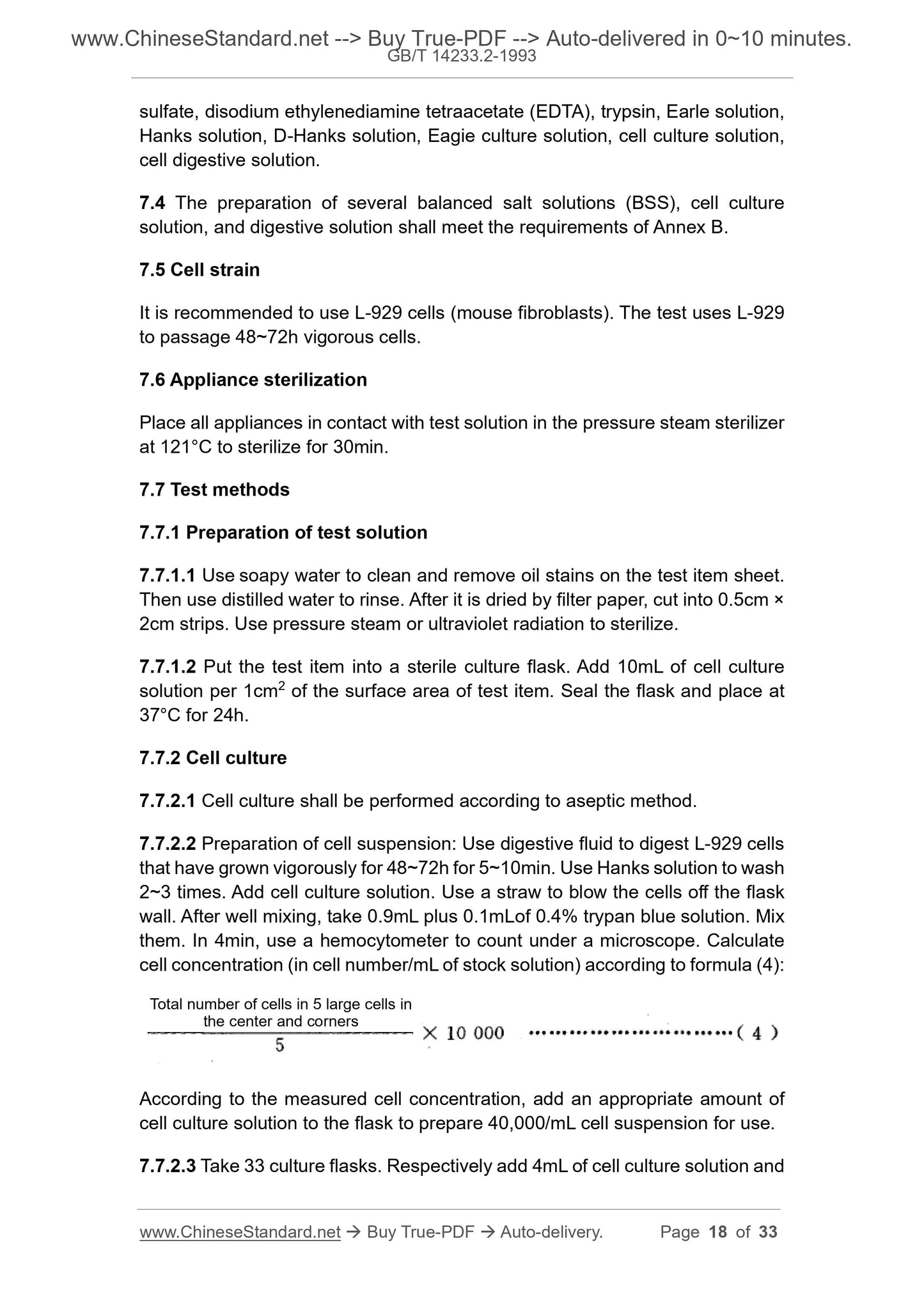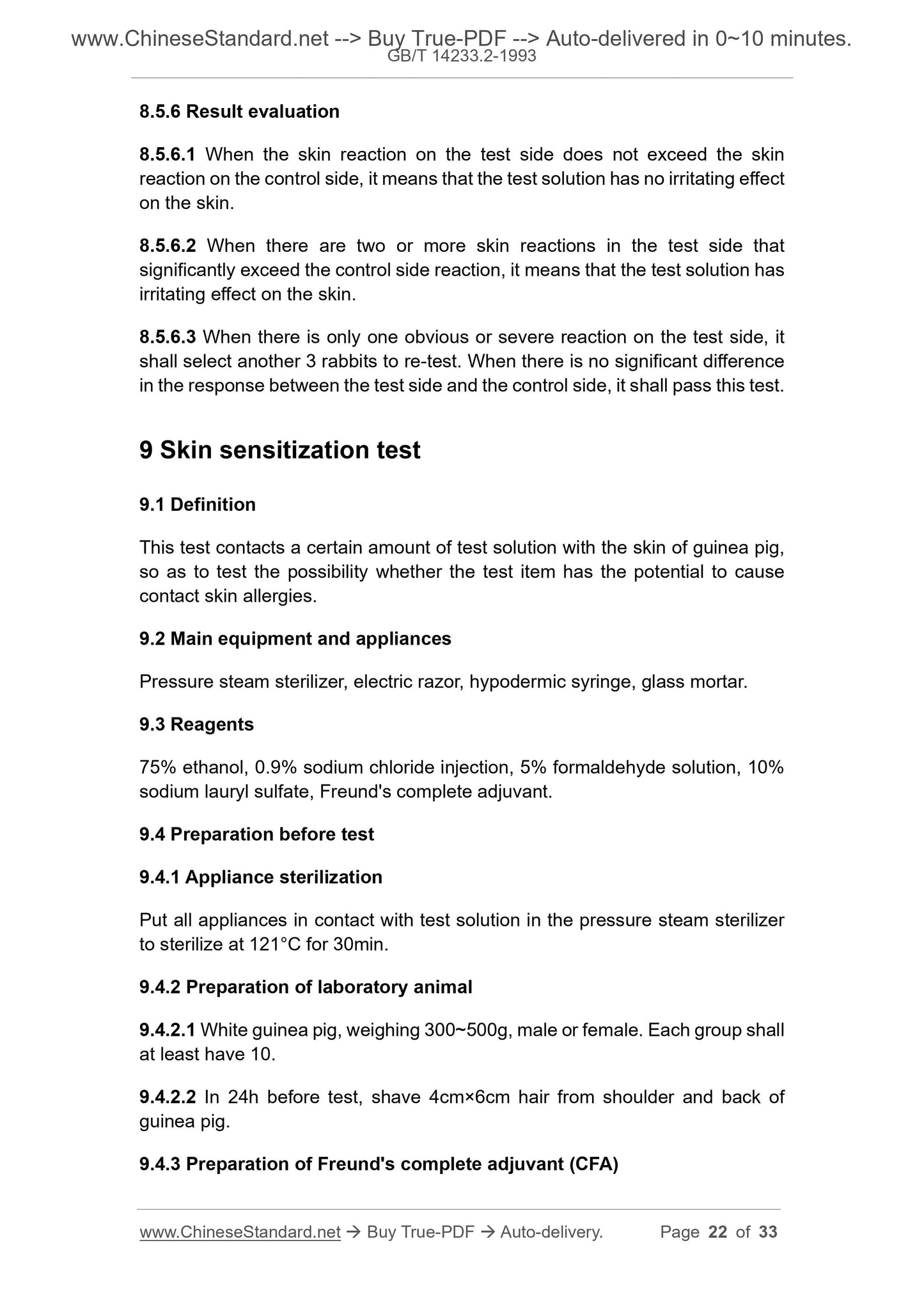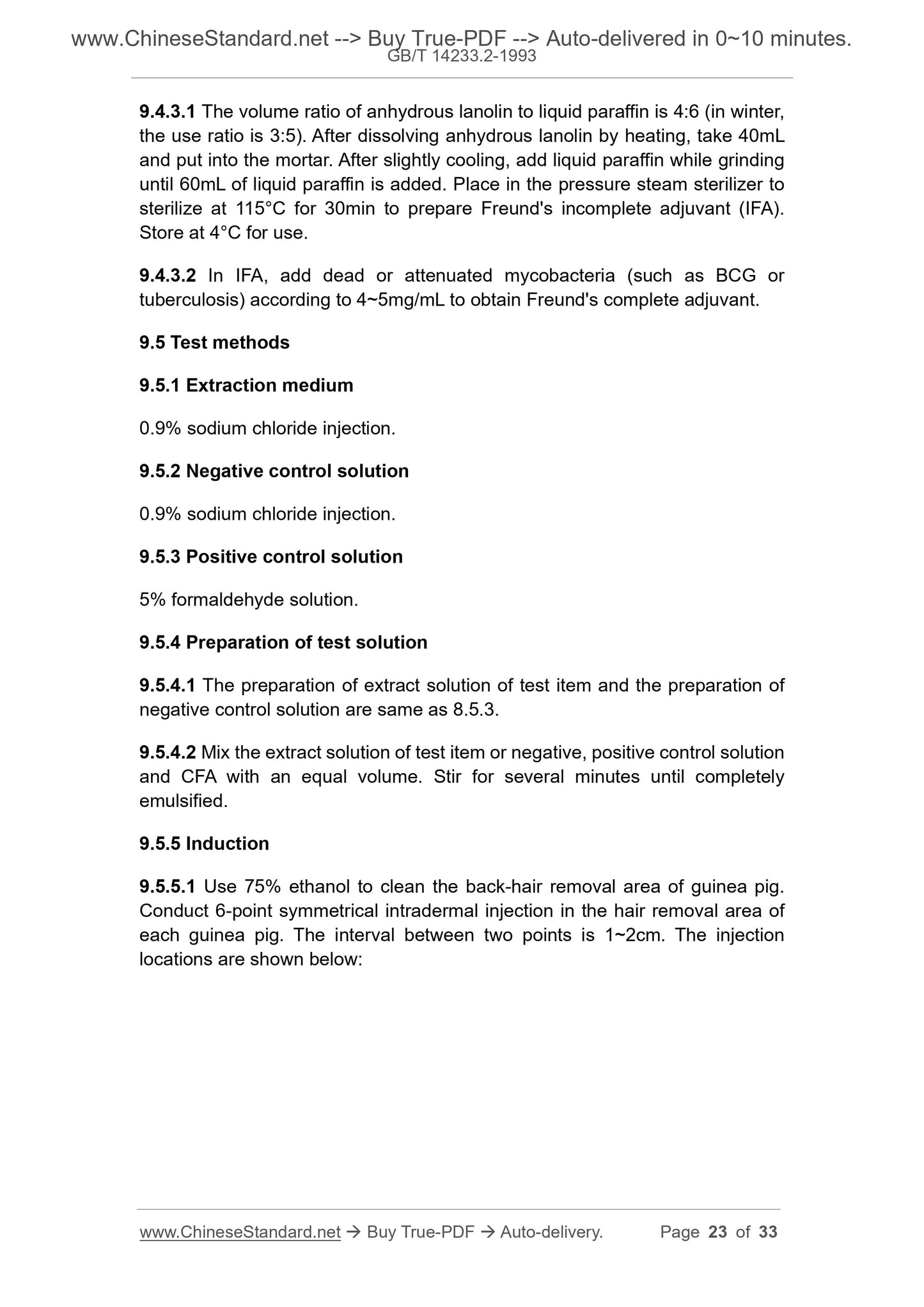1
/
of
12
PayPal, credit cards. Download editable-PDF and invoice in 1 second!
GB/T 14233.2-1993 English PDF (GBT14233.2-1993)
GB/T 14233.2-1993 English PDF (GBT14233.2-1993)
Regular price
$265.00 USD
Regular price
Sale price
$265.00 USD
Unit price
/
per
Shipping calculated at checkout.
Couldn't load pickup availability
Delivery: 3 seconds. Download true-PDF + Invoice.Newer version: (Replacing this standard) GB/T 14233.2-2005
Get QUOTATION in 1-minute: Click GB/T 14233.2-1993
Historical versions: GB/T 14233.2-1993
Preview True-PDF (Reload/Scroll if blank)
GB/T 14233.2-1993: Test methods for infusion, transfusion, injection equipment for medical use. Part 2: Biological test methods
GB/T 14233.2-1993
NATIONAL STANDARD OF THE
PEOPLE’S REPUBLIC OF CHINA
UDC 615.473
C 31
GB/T 14233.2-93
Infusion, transfusion, injection equipment for medical
use - Part 2: Biological test methods
APPROVED ON: MARCH 16, 1993
IMPLEMENTED ON: NOVEMBER 01, 1993
Issued by: National Technical Supervision Bureau
Replaced
Table of Contents
1 Subject content and application scope ... 3
Chapter One -- Finished product test ... 3
2 Sterility test ... 3
3 Rabbit pyrogen test ... 6
4 Bacterial endotoxin test ... 10
5 Acute systemic toxicity test ... 13
6 Hemolysis test ... 15
Chapter Two -- Material test ... 17
7 Cytotoxicity test ... 17
8 Intradermal stimulation test ... 20
9 Skin sensitization test ... 22
10 Short-term muscle implantation test ... 25
Annex A Preparation of mediums ... 29
Annex B Preparations of cell culture solution, digestive solution, balanced salt
solution (Supplementary) ... 31
Additional information: ... 33
Infusion, transfusion, injection equipment for medical
use - Part 2: Biological test methods
1 Subject content and application scope
This Standard specifies biological performance test methods for finished
products and materials of infusion, transfusion, injection equipment for syringes.
This Standard is applicable to biological performance tests of infusion,
transfusion, injection and supporting equipment that are made of medical
polymer materials. Other medical polymer products can also refer to this
Standard for use.
Chapter One -- Finished product test
2 Sterility test
2.1 Definition
Sterility test is a method to check whether the test article is sterile.
2.2 Main equipment
Ultra-clean bench, optical microscope, constant-temperature incubator,
pressure steam sterilizer, electric heating oven.
2.3 Reagents
Peptone, beef extract, yeast extract, agar, glucose, potassium dihydrogen
phosphate, sodium chloride, sodium hydroxide, magnesium sulfate, trypsin, L-
cystine, sodium thioglycolate, 0.9% sodium chloride injection liquid.
2.4 Medium
2.4.1 Preparation of medium
2.4.1.1 First, peptone, beef extract, yeast extract, agar used for medium shall
prepare a small amount of medium to observe if they are cloudy after
sterilization and if the growth of bacteria is good. Try again when changing
factory designation.
must not exceed 3, no more than 4 colonies in a single dish.
Check the sterility of the sterile room during the sterility test in the same method
as above. At the beginning of the test, open the dish cover and expose it to the
air. At the end of the test, cover it and incubate according to the method
mentioned above, according to the above requirements.
2.6 Preparation of control bacterial solution
Staphylococcus aureus bacterial solution: Take common agar beveled fresh
culture of staphylococcus aureus (26 003) to inoculate a platinum ear into the
aerobic and anaerobic medium. After incubating at 30~35°C for 16~18h, use
sterile 0.9% sodium chloride injection to dilute into 1:106 to obtain.
2.7 Test methods
2.7.1 Number of test items
The same lot at least has 3 units of test items.
2.7.2 Extraction medium
0.9% sterile sodium chloride injection.
2.7.3 Preparation and inoculation of test solution
2.7.3.1 Preparation and inoculation of test solution shall be performed
according to aseptic method.
2.7.3.2 Tube appliances: According to 1mL of extraction medium per 10cm2 of
the internal surface area of the tube, the flow is 10mL/min.
2.7.3.3 Containers: If the container is already filled with liquid, the liquid in the
container can be directly extracted as test solution. If it is not filled with liquid, it
shall add 1mL of extraction medium per 10cm2 of surface area in the container.
Shake several times.
2.7.3.4 Small accessories or solid appliances: Small accessories or solid
appliances can be dropped directly into the medium. For large solid appliances,
add 1mL of extraction medium per 10cm2 of surface area. Shake several times.
2.7.3.5 Test solution shall be used within 2h after preparation.
2.7.3.6 Each lot of test solutions are respectively inoculated into 5 tubes of
aerobic and anaerobic medium. One tube is used to inoculate 1mL of
staphylococcus aureus solution for positive control. Two tubes are used to
inoculate mold medium. The inoculation volume of each tube of test solution
and the amount of medium to be sub-packed are according to Table 1.
3.3 Reagents
0.9% sodium chloride injection.
3.4 Rabbit for trial
3.4.1 General requirements
The rabbit for trial shall be healthy and free of injuries. It shall have smooth hair,
a normal anus. Its weight shall be 1.7~3.0kg. It can be male or female. If it is a
female rabbit, it shall not be pregnant. In 7d before temperature measurement,
it shall be raised on the same feed. During this period, it shall not lose weight.
There shall be no abnormalities in spirit, appetite, excretion, etc.
3.4.2 Selection of rabbit for trial
3.4.2.1 For a new rabbit that hasn’t used for pyrogen inspection, it shall pre-
measure the temperature of the rabbit in 7d before the test to select. The
conditions for selecting the test are the same as for the test item. But there is
no injection. Measure the body temperature once every 1h, 4 times in total.
When the temperatures measured are within 38.0~39.6°C and the difference
between the highest temperature and the low temperature does not exceed
0.4°C, it shall comply with the provisions and can be used for test.
3.4.2.2 For a rabbit that has been used for pyrogen inspection, if the test item
complies with the provisions, it shall rest for at least 48h before it is used for the
second inspection. If the rabbit has a temperature rise of 0.6°C, it shall rest for
more than two weeks. Then measure its temperature as for a new rabbit. It can
be used for the test after its temperature meets the requirements. If the test
item fails to comply with the provisions and when the average rabbit
temperature in the group reaches 0.8°C or greater, all the rabbits in the group
are no longer used. Rabbits that two temperature rises or drops outside the
qualified range are also no longer used.
3.4.2.3 If the interval between two uses is more than 3 weeks, the temperature
shall be measured as for a new rabbit.
3.4.2.4 Each rabbit shall not be used more than 10 times.
3.5 Preparation before test
3.5.1 Appliance sterilization and depyrogen
Place all appliances that are in contact with the test solution in the electric drying
oven to dry at 180°C for 2h or at 250°C for 30min.
3.5.2 Verification of anal thermometer
The interval time is 30~60min. The difference between two temperatures shall
not exceed 0.2°C. Take the average of two body temperatures as the normal
temperature of the rabbit. The body temperature of the rabbit used on the day
shall be in the range of 38.0~39.6°C. For test rabbits in the same lot, the
difference in normal body temperature between rabbits shall not exceed 1°C.
3.6.4.3 Temperature measurement method: Put the rabbit in a holder to prevent
it from commotion. Start the first temperature measurement in 30min. Slowly
insert an anal thermometer or temperature probe into the rabbit's anus, with a
depth of 6cm. The temperature measurement time for each rabbit shall at least
be 2min. If the rabbit is turbulent during temperature measurement, wait for
10min before measuring temperature again.
3.6.5 Inje...
Get QUOTATION in 1-minute: Click GB/T 14233.2-1993
Historical versions: GB/T 14233.2-1993
Preview True-PDF (Reload/Scroll if blank)
GB/T 14233.2-1993: Test methods for infusion, transfusion, injection equipment for medical use. Part 2: Biological test methods
GB/T 14233.2-1993
NATIONAL STANDARD OF THE
PEOPLE’S REPUBLIC OF CHINA
UDC 615.473
C 31
GB/T 14233.2-93
Infusion, transfusion, injection equipment for medical
use - Part 2: Biological test methods
APPROVED ON: MARCH 16, 1993
IMPLEMENTED ON: NOVEMBER 01, 1993
Issued by: National Technical Supervision Bureau
Replaced
Table of Contents
1 Subject content and application scope ... 3
Chapter One -- Finished product test ... 3
2 Sterility test ... 3
3 Rabbit pyrogen test ... 6
4 Bacterial endotoxin test ... 10
5 Acute systemic toxicity test ... 13
6 Hemolysis test ... 15
Chapter Two -- Material test ... 17
7 Cytotoxicity test ... 17
8 Intradermal stimulation test ... 20
9 Skin sensitization test ... 22
10 Short-term muscle implantation test ... 25
Annex A Preparation of mediums ... 29
Annex B Preparations of cell culture solution, digestive solution, balanced salt
solution (Supplementary) ... 31
Additional information: ... 33
Infusion, transfusion, injection equipment for medical
use - Part 2: Biological test methods
1 Subject content and application scope
This Standard specifies biological performance test methods for finished
products and materials of infusion, transfusion, injection equipment for syringes.
This Standard is applicable to biological performance tests of infusion,
transfusion, injection and supporting equipment that are made of medical
polymer materials. Other medical polymer products can also refer to this
Standard for use.
Chapter One -- Finished product test
2 Sterility test
2.1 Definition
Sterility test is a method to check whether the test article is sterile.
2.2 Main equipment
Ultra-clean bench, optical microscope, constant-temperature incubator,
pressure steam sterilizer, electric heating oven.
2.3 Reagents
Peptone, beef extract, yeast extract, agar, glucose, potassium dihydrogen
phosphate, sodium chloride, sodium hydroxide, magnesium sulfate, trypsin, L-
cystine, sodium thioglycolate, 0.9% sodium chloride injection liquid.
2.4 Medium
2.4.1 Preparation of medium
2.4.1.1 First, peptone, beef extract, yeast extract, agar used for medium shall
prepare a small amount of medium to observe if they are cloudy after
sterilization and if the growth of bacteria is good. Try again when changing
factory designation.
must not exceed 3, no more than 4 colonies in a single dish.
Check the sterility of the sterile room during the sterility test in the same method
as above. At the beginning of the test, open the dish cover and expose it to the
air. At the end of the test, cover it and incubate according to the method
mentioned above, according to the above requirements.
2.6 Preparation of control bacterial solution
Staphylococcus aureus bacterial solution: Take common agar beveled fresh
culture of staphylococcus aureus (26 003) to inoculate a platinum ear into the
aerobic and anaerobic medium. After incubating at 30~35°C for 16~18h, use
sterile 0.9% sodium chloride injection to dilute into 1:106 to obtain.
2.7 Test methods
2.7.1 Number of test items
The same lot at least has 3 units of test items.
2.7.2 Extraction medium
0.9% sterile sodium chloride injection.
2.7.3 Preparation and inoculation of test solution
2.7.3.1 Preparation and inoculation of test solution shall be performed
according to aseptic method.
2.7.3.2 Tube appliances: According to 1mL of extraction medium per 10cm2 of
the internal surface area of the tube, the flow is 10mL/min.
2.7.3.3 Containers: If the container is already filled with liquid, the liquid in the
container can be directly extracted as test solution. If it is not filled with liquid, it
shall add 1mL of extraction medium per 10cm2 of surface area in the container.
Shake several times.
2.7.3.4 Small accessories or solid appliances: Small accessories or solid
appliances can be dropped directly into the medium. For large solid appliances,
add 1mL of extraction medium per 10cm2 of surface area. Shake several times.
2.7.3.5 Test solution shall be used within 2h after preparation.
2.7.3.6 Each lot of test solutions are respectively inoculated into 5 tubes of
aerobic and anaerobic medium. One tube is used to inoculate 1mL of
staphylococcus aureus solution for positive control. Two tubes are used to
inoculate mold medium. The inoculation volume of each tube of test solution
and the amount of medium to be sub-packed are according to Table 1.
3.3 Reagents
0.9% sodium chloride injection.
3.4 Rabbit for trial
3.4.1 General requirements
The rabbit for trial shall be healthy and free of injuries. It shall have smooth hair,
a normal anus. Its weight shall be 1.7~3.0kg. It can be male or female. If it is a
female rabbit, it shall not be pregnant. In 7d before temperature measurement,
it shall be raised on the same feed. During this period, it shall not lose weight.
There shall be no abnormalities in spirit, appetite, excretion, etc.
3.4.2 Selection of rabbit for trial
3.4.2.1 For a new rabbit that hasn’t used for pyrogen inspection, it shall pre-
measure the temperature of the rabbit in 7d before the test to select. The
conditions for selecting the test are the same as for the test item. But there is
no injection. Measure the body temperature once every 1h, 4 times in total.
When the temperatures measured are within 38.0~39.6°C and the difference
between the highest temperature and the low temperature does not exceed
0.4°C, it shall comply with the provisions and can be used for test.
3.4.2.2 For a rabbit that has been used for pyrogen inspection, if the test item
complies with the provisions, it shall rest for at least 48h before it is used for the
second inspection. If the rabbit has a temperature rise of 0.6°C, it shall rest for
more than two weeks. Then measure its temperature as for a new rabbit. It can
be used for the test after its temperature meets the requirements. If the test
item fails to comply with the provisions and when the average rabbit
temperature in the group reaches 0.8°C or greater, all the rabbits in the group
are no longer used. Rabbits that two temperature rises or drops outside the
qualified range are also no longer used.
3.4.2.3 If the interval between two uses is more than 3 weeks, the temperature
shall be measured as for a new rabbit.
3.4.2.4 Each rabbit shall not be used more than 10 times.
3.5 Preparation before test
3.5.1 Appliance sterilization and depyrogen
Place all appliances that are in contact with the test solution in the electric drying
oven to dry at 180°C for 2h or at 250°C for 30min.
3.5.2 Verification of anal thermometer
The interval time is 30~60min. The difference between two temperatures shall
not exceed 0.2°C. Take the average of two body temperatures as the normal
temperature of the rabbit. The body temperature of the rabbit used on the day
shall be in the range of 38.0~39.6°C. For test rabbits in the same lot, the
difference in normal body temperature between rabbits shall not exceed 1°C.
3.6.4.3 Temperature measurement method: Put the rabbit in a holder to prevent
it from commotion. Start the first temperature measurement in 30min. Slowly
insert an anal thermometer or temperature probe into the rabbit's anus, with a
depth of 6cm. The temperature measurement time for each rabbit shall at least
be 2min. If the rabbit is turbulent during temperature measurement, wait for
10min before measuring temperature again.
3.6.5 Inje...
Share
